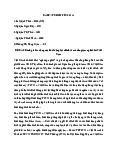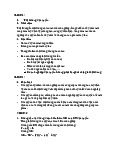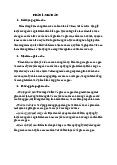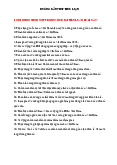


Preview text:
CHAPTER 20 INTERNATIONAL TRADE TRUE-FALSE QUESTIONS
1. A trade deficit occurs when imports are greater than exports
2. Examples of capital – intensive goods would be automobiles, machinery and chemicals
3. The principle of comparative advantage is that total output will be greatest when each
good is produced by that nation which has the higher domestic opportunity cost
4. By specializing based on comparative advantage, nations can obtain larger outputs with fixed amounts of resources
5. The terms of trade determine how the increase in world output resulting from
comparative advantage is shared by trading nations
6. Increasing opportunity costs tend to prevent specialization among trading nations from being compete
7. A nation will export a particular product if the world price is less than the domestic price
8. In a two-country model, equilibrium in world prices and quantities of exports and imports
will occur where one nation’s export supply curve intersects the other nation’s import demand curve
9. The imposition of a tariff on a good imported from abroad will reduce the amount of the imported good that is bought.
10. The major difference between a tariff and a quota on an imported products is that a quota
produces revenue for the government MULTIPLE – CHOICE QUESTIONS
1. Nations engage in trade because
A. World resources are evenly distributed among nations
B. World resources are unevenly distributed among nations
C. All products are produced from the same technology
D. All products are produced from the same combinations of resources
Uses the following tables to answer the questions
NEPAL PRODUCTION POSSIBILITIES TABLE PRODUCTION ALTERNATIVES Product A B C D E F Yak fat 0 4 8 12 16 20 Camel hides 40 32 24 16 7 0
KASHMIR PRODUCTION POSSIBILITIES TABLE PRODUCTION ALTERNATIVES Product A B C D E F Yak fat 0 3 6 9 12 15 Camel hides 60 48 36 24 12 0
2. The data in the tables show that production in
A. Both Nepal and Kashmir are subject to increasing opportunity costs
B. Both Nepal and Kashmir are subject to constant opportunity costs
C. Nepal is subject to increasing opportunity costs and Kashmir to constant opportunity costs
D. Kashmir is subject to increasing opportunity costs and Nepal to constant opportunity costs
3. If Nepal and Kashmir engage in trade, the terms of trade will be
A. Between 2 and 4 camel hides for 1 unit of yak fat
B. Between 1/3 and ½ units of yak fat for 1 camel hide
C. Between 3 and 4 units of yak fat for 1 camel hide
D. Between 2 and 4 units of yak fat for 1 camel hide
4. Assume that prior to specialization and trade Nepal and Kashmir both choose production
possibility C. now if each specializes according to its comparative advantage, the
resulting gains from specialization and trade will be A. 6 units of yak fat B. 8 units of yak fat
C. 6 units of yak fat and 8 camel hide
D. 8 units of yak fat and 6 camel hide
5. Each nation produced only one product in accordance with its comparative advantage,
and the terms of trade were set at 3 camel hides for 1 unit of yak fat. In this case, Nepal
could obtain a maximum combination of 8 units of yak fat and A. 12 camel hides B. 24 camel hides C. 36 camel hides D. 48 camel hides
6. What happens to a nation’s imports or exports of a product when the world price of the
product rises above the domestic price?
A. Imports of the product increase
B. Imports of the product stay the same
C. Exports of the product increase
D. Exports of the product decrease
7. What happens to a nation’s imports or exports of a product when the world price of the
product falls below the domestic price?
A. Imports of the product increase
B. Imports of the product decrease
C. Exports of the product increase
D. Exports of the product stay the same
8. Which one of the following is characteristic of tariffs?
A. They prevent the importation of goods from abroad
B. They specify the maximum amounts of specific commodities that may be imported during a given period of time
C. They offer protect domestic producers from foreign competition
D. They enable nations to reduce their exports and increase their imports during periods of recession
9. The motive for barriers to the importation of goods and services from abroad is to
A. Improve economic efficiency in that nation
B. Protect and benefit domestic producers of those goods and services
C. Reduce the prices of the goods and services produced in that nation
D. Expand the export of goods and services to foreign nations
10. When a tariff is imposed on a good imported from abroad
A. The demand for good increases
B. The demand for the good decreases
C. The supply of the good increases
D. The supply of the good decreases




